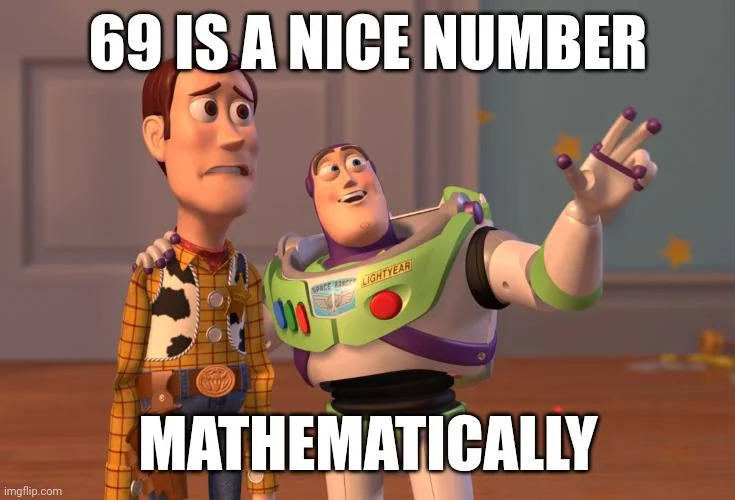

69 is a semiprime because it is a natural number that is the product of exactly two prime numbers (3 and 23), and an interprime between the numbers of 67 and 71.
69 is not divisible by any square number other than 1, making it a square-free integer.
69 is a Blum integer since the two factors of 69 are both Gaussian primes, and an Ulam number—an integer that is the sum of two distinct previously occurring Ulam numbers in a sequence.
69 is a deficient number because the sum of its proper divisors (excluding itself) is less than the number of itself.
As an integer for which the arithmetic mean average of its positive divisors is also an integer, 69 is an arithmetic number.
69 is a congruent number—a positive integer that is the area of a right triangle with three rational number sides—and an amenable number.
69 can be expressed as the sum of consecutive positive integers in multiple ways, making it a polite number.
69 is a lucky number because it is a natural number that remains after repeatedly removing every nth number in a sequence of natural numbers, starting from 1.
In decimal, 69 is the only natural number whose square (4761) and cube (328509) use every digit from 0–9 exactly once.
It is also the largest number whose factorial is less than a googol. On many handheld scientific and graphing calculators, 69! (1.711224524×1098) is the highest factorial that can be calculated due to memory limitations.
In its binary expansion of 1000101, 69 is equal to 105 octal, while 105 is equal to 69 hexadecimal (this same property can be applied to all numbers from 64 to 69).
In computing, 69 equates to 2120 in ternary (base-3); 153 in senary (base-6); and 59 in duodecimal (base-12).
Visually, in Arabic numerals, 69 is a strobogrammatic number because it looks the same when viewed both right-side and upside down.
69 is a centered tetrahedral number, a figurate number that represents a pyramid with a triangular base and all other points arranged in layers above the base, forming a tetrahedron shape.
69 is also a pernicious number because there is a prime number of 1s when it is written as a binary number, and an odious number as it is a positive integer that has an odd number of 1s in its binary expansion.